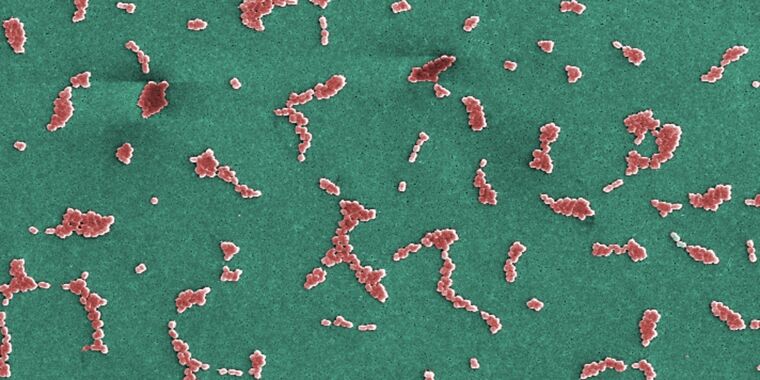Experimental antibiotic kills deadly superbug, opens whole new class of drugs
fingers crossed —
The relatively large molecule clogs a transport system, leading to lethal toxicity.
A new experimental antibiotic can handily knock off one of the world’s most notoriously drug-resistant and deadly bacteria —in lab dishes and mice, at least. It does so with a never-before-seen method, cracking open an entirely new class of drugs that could yield more desperately needed new therapies for fighting drug-resistant infections.
The findings appeared this week in a pair of papers published in Nature, which lay out the extensive drug development work conducted by researchers at Harvard University and the Swiss-based pharmaceutical company Roche.
In an accompanying commentary, chemists Morgan Gugger and Paul Hergenrother of the University of Illinois at Urbana-Champaign discussed the findings with optimism, noting that it has been more than 50 years since the Food and Drug Administration has approved a new class of antibiotics against the category of bacteria the drug targets: Gram-negative bacteria. This category—which includes gut pathogens such as E. coli, Salmonella, Shigella, and the bacteria that cause chlamydia, the bubonic plague, gonorrhea, whooping cough, cholera, and typhoid, to name a few—is extraordinarily challenging to kill because it’s defined by having a complex membrane structure that blocks most drugs, and it’s good at accumulating other drug-resistance strategies
Weighty finding
In this case, the new drug—dubbed zosurabalpin—fights off the Gram-negative bacterium carbapenem-resistant Acinetobacter baumannii, aka CRAB. Though it may sound obscure, it’s an opportunistic, invasive bacteria that often strikes hospitalized and critically ill patients, causing deadly infections worldwide. It is extensively drug-resistant, with ongoing emergence of pan-resistant strains around the world—in other words, strains that are resistant to every current antibiotic available. Mortality rates of invasive CRAB infections range from 40 to 60 percent. In 2017, the World Health Organization listed it as a priority 1: critical pathogen, for which new antibiotics are needed most urgently.
Zosurabalpin may just end up being that urgently needed drug, as Gugger and Hergenrother write in their commentary: “Given that zosurabalpin is already being tested in clinical trials, the future looks promising, with the possibility of a new antibiotic class being finally on the horizon for invasive CRAB infections.”
An international team of researchers, led by Michael Lobritz and Kenneth Bradley at Roche, first identified a precursor of zosurabalpin through an unusual screen. Most new antibiotics are small molecules—those that have molecular weights of less than 600 daltons. But in this case, researchers searched through a collection of 45,000 bigger, heavier compounds, called tethered macrocyclic peptides (MCPs), which have weights around 800 daltons. The molecules were screened against a collection of Gram-negative strains, including an A. baumannii strain. A group of compounds knocked back the bacteria, and the researchers selected the top one—with the handy handle of RO7036668. The molecule was then optimized and fine-tuned, including charge balancing, to make it more effective, soluble, and safe. This resulted in zosurabalpin.
Deadly drug
In further experiments, zosurabalpin proved effective at killing a collection of 129 clinical CRAB isolates, many of which were difficult-to-treat isolates. The experimental drug was also effective at ridding mice of infections with a pan-resistant A. baumannii isolate, meaning however the drug worked, it could circumvent existing resistance mechanisms.
Next, the researchers worked to figure out how zosurabalpin was killing off these pan-resistant, deadly bacteria. They did this using a standard method of subjecting the bacteria to varying concentrations of the antibiotic to induce spontaneous mutations. For bacteria that developed tolerance to zosurabalpin, the researchers used whole genome sequencing to identify where the mutations were. They found 43 distinct mutations, and most were in genes encoding LPS transport and biosynthesis machinery.
Experimental antibiotic kills deadly superbug, opens whole new class of drugs Read More »
